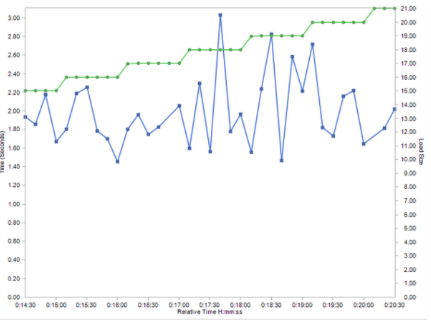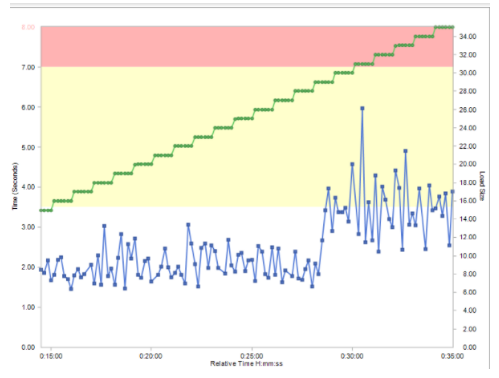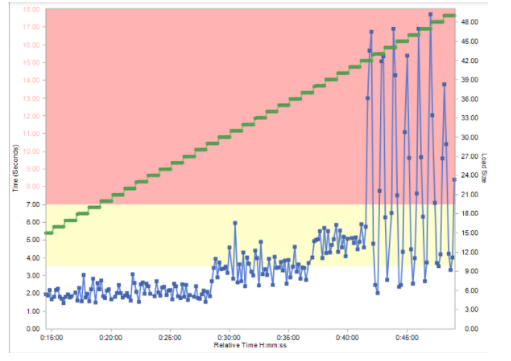Load Testing Through A Customer’s Point of View
12 min read
“Load testing is hard to implement if you don’t have specific tools and testing knowledge.” It should be done throughout the project rather than at the end. Since by that time, the system architecture has been developed.
Similarly, infrastructure deployments have been created and procured. There is no meaning for making modifications in architecture when everything is already in its place.
For companies that don’t perform load testing daily prior to production implementations, their users start becoming de facto QA testers, and various performance issues occur because the size of their users grows faster.
That’s why when it comes to customer satisfaction, load testing should be done early as possible. Otherwise, this process can help you experience high expenses when you consider making changes later in the lifecycle.
What is Load Testing & Why Is It Important Part of the Software Development Life Cycle?
Load testing is the method of putting a software system under stress and evaluating how it responds. The term load testing is often described in different ways because there are several professional software testing communities that have different mindsets and methodologies to ensure the success of load testing projects.
However, load testing is generally defined as the process in which we check how many users can access the software at the same time. Moreover, with this testing, you can check the expected usage of a software program when it is accessed by multiple users concurrently.
Furthermore, performing load testing is crucial for mobile and web applications because customers are dependent on these apps and regularly use them to shop products and services and for various purposes.
Therefore, load testing is necessary to perform to examine how well the application will perform at the user end and when the load testing company conducts this testing, it tells how much time the app will take to load the particular content and element that are available on the site or mobile app.
In Software Development Lifecycle, load testing is vital for the following reasons.
- Load Testing Simulates Real User Scenarios
When you test your website, API endpoint, an app under a load, it simulates how well the website or applications will perform when hundreds of thousands of millions of users access it in real life. Yes, you may hear right that the purpose of load testing services is to check how users will use your product or system in real-time.
Clearly, we can say that load testing is necessary to improve the website performance and help your users use the app properly. Furthermore, understanding the number of bugs in the web and mobile app and fixing those bugs or defects are among the most important factor that you have to keep in mind while performing load testing. Otherwise, it would be hard for you to give the best user experience.
Moreover, depending on the size of your resources, labs, test cases, you can start from functional testing and then move to different types of performance testing such as load testing, capacity testing, stress testing, and soak testing. Each type has a different meaning and implements according to the different project requirements.
For instance,
In load testing, every load tester considers this testing as the bread and butter, and they test how a system will behave when a large number of users use it and check the response time for pages under distinct scenarios. Suppose the below graph demonstrates that you are running a load of 20 users and ensuring that page time should not exceed more than 3.5 seconds.

Capacity Testing: Capacity Testing or scalability Testing is the type of testing in which you identify the maximum capacity of your system that can support a number of users while not exceeding a page time that you define. In the previous graph, we have seen that the system can bear a load of 20 users with a page time of 3.5 seconds.
Now it is time to identify the accurate capacity of your system in which it doesn’t maintain the response time of 3.5 seconds. Based on the size of your 21 users, 30, 40, 50, etc., you can calculate the highest and lowest capacity of your system. Make sure the objective of capacity is to examine the ‘safety zone’ of your system without hampering the end-user experience.

In the above graph, you can notice that when the page time is 3.5 seconds, the system can support approx. 28 users. However, when the load size goes to 29 users, the page time also starts exceeding and takes more time than 3.5 seconds.
Stress Testing
Stress testing aims to find how a system performs in extreme conditions. In this process, you deliberately try to break your system by leveraging any set of extreme situations – For example, by maximizing the size of your users or using less memory, or a database server with a weaker CPU.
The chief purpose of performing stress testing is to check how well the system behaves under stress, plus it also allows you to know the user experience – bad or good. Nevertheless, while performing stress testing, the following are the queries that can come to your mind.
- Will response time double?
- Will the system start throwing out errors?
- Will the entire system get crash?
As in the previous example, when the number of users increases, the page time can exceed, or you can assume it maximizes the user load on your system. If there are 30 users on your page and at the time of load testing, it gets increased by 11% and reached 41, your system will start showing deterioration and may take about 15 to 17 seconds to respond on a particular page.

Soak Testing
Soak testing is used to find performance issues that only appear after a long period of time. During soak testing, you maybe ask yourself questions like:
- Is there a steady degradation in response time when the system operates over time?
- Are there any system resource degradations that aren’t visible during short runs but become apparent when a test is run for a prolonged period of time? For instance, free disk space, memory consumptions, machine handles, etc.
- Is there any systematic procedure that may have an impact on the system’s performance but can only be recognized after a long run? For instance, a daily backup process, data exporting to a third-party system, and so on.
So, in Soak Testing, the load testing company checks for trends and changes in the system’s behavior. Similarly, testers test the system to understand its behavior and analyze whether it is working as expected or not, especially if it is tested for one hour.
However, when this system is tested for two or three hours, some problems start to arise, such as memory leaks, because at this stage, your system may experience a failure issue or behave unexpectedly. Therefore, when it comes to checking a subject’s reaction under test for a given threshold and duration, it becomes necessary to perform soak testing. Moreover, observations that you may make during soak testing can be used to enhance the subject’s characteristics throughout subsequent tests.
- Performance Under Load
Performance indicators such as memory leakage, response time, TTFB, CPU, etc., might be necessary for the single user because when your site gets a load of 1000s users across the globe, sometimes indicators start giving error signals.
Moreover, another factor that you have to keep in mind is your website’s speed because it plays a crucial role in search engines. So, you have to optimize it well through load testing, or you can consider load testing services to fix performance glitches, if any contain by your website or if there are lots of hits on the webserver.
Still, it would be helpful to think of various types of load testing in case of sudden traffic spike, randomly increasing and decreasing of the load, or when the load becomes massive for an extended period because all such factors can hamper your site’s performance as well as down your company’s reputation if you don’t take any action on time.
One of the main benefits of load testing or getting a load test for your site is that it allows you to identify when your system breaks and make it feasible to fix the problem and avoid unexpected errors. By doing this, you can help your customer get better results through your website and improve your brand’s reputation.
- Monitor the Scalability of App
Load testing assists you in finding the maximum number of concurrent users that your web app can support. Besides, with the help of load testing, testers can have extra resources in their hand as a backup to fulfill the potential demands in the event of high traffic.
- Reduce Downtime
Preventing downtime is easy when you already how many users the site can handle without crashing. In general, when a website doesn’t perform functions for the users or show the offline status, we can call it downtime. To avoid this situation, one should have experts of the load testing service provider or particular resources to fulfill the site’s requirement.
Additionally, you don’t prepare your site, and if the traffic comes suddenly to your web page, then you can experience Downtime issues. However, you don’t need to worry if you are performing load testing on your website because it supports you to improve the site downtime and alerts you when your site will go down so that you can take quick action and control this situation.
- Don’t Frustrate your Users.
Make sure your users will like you when you offer them high-quality results with a high-speed website. They can’t tolerate the poor performance, especially if it is the matter to buy something immediately and get the doorstep delivery within one to two days.
In addition, in case of slow sites and crash issues, your users may start posting bad comments on social media. Also, if your site will take more than 3 seconds while loading, they may change their choice and don’t trust your service or site again because your users want a smooth working on the site. Thus, to ensure whether the site’s functions are working appropriately or not, you should conduct a load test to enhance your user experience and marketing.
- Code Changes Affect Product Quality
Coding is an ongoing process if the site is fully customized and you are allowed to make changes in a repeated manner. Therefore, if the testing doesn’t perform after making modifications on the site, then it is difficult to say whether your users will get the same experience or your site will annoy them because usually, the site loads correctly for the first time, but after making changes on the site or when there are two or more dependencies on your platform, your site may take time to load.
Thus, if you want to run your website smoothly and allow it to behave well under pressure, don’t forget to operate load testing as it will not only help you fix the issues but also protect you from future risks that you can experience after making new changes on the web app. Apart from this, you must be aware of irregular holiday traffic.
For example, Halloween, Diwali, Black Friday, Cyber Monday, and Christmas are the major festivals when people love to shop. During this time, you can experience a huge amount of traffic, especially if you are offering some deals, coupons, gifts on your site to attract your visitors. But are you prepared for irregular holiday traffic? Are you sure that your site can handle too much load? If not, you should operate with the load testing because only this type of testing can help you handle all the traffic and sales and lets your users get a positive experience.
Thence, if you want to save your online business from any unexpected problem, you can perform the load test on a regular basis to know the status of your site’s performance and other factors that are critical to ensure your company’s success.
How to Get the Load Testing Done Right for Potential Customers?
Develop a Proper Strategy for Load Testing
Web applications, mobile apps, or systems that contain any sensitive information about your users should have a proper strategy before load testing. Since, with a robust testing strategy, you can assure that implementation will be done smoothly and all the bugs or defects will fix carefully.
Though testing is as essential as the test plan, that’s why you should build an effective test plan and keep it in synchronization will all your testing requirements. Also, you should focus on the results that your users want.
For load testing, consider all major pitfalls and challenges because they can hinder performance or create bottlenecks in your software application. Therefore, you should have a thorough strategy according to every functionality, feature, and component of the application to design a realistic workload and monitor the app’s performance.
Into the bargain, you should also consider the entire nature of the application with business goals whenever you plan to make a robust strategy for your load testing implementation. With a comprehensive approach, you can streamline your testing efforts and save you a lot of time during testing.
Manual Load Testing
There are two ways to perform load testing – either through manual load testing or automation-based load testing. If you have the highest number of load requirements, or you can understand, you have many more things on your plate for testing. Yet, in this case, you can skip manual testing because it will require more time and may cost you more compared to automation testing.
On the flip side, for automation load testing, several open-source load testing tools and enterprise-level tools are available on the market that you can check for your load testing services or get your load testing in the right way. Some of the examples of open-source load testing and corporate/enterprise level load testing tools are as follow:
- Apache JMeter
- Locust
- Tsung
- Httperf
- JCrawler
- WebLOAD
- Apica
- Silk Performer
- nGrinder
- NeoLoad
Understand the Difference Between Performance, Load & Stress Testing
The terms performance, load, and stress testing often look similar. However, in reality, they differ from one another. To help you understand the distinction between all three, we have mentioned a bit of information about Performance, Stress Testing, and Load Testing below:
Performance Testing
The practice of testing software in order to understand its speed, stability, and responsiveness is called performance testing. Overall, the performance test aims to provide an insight into how the software app will behave under normal circumstances.
Stress Testing
On the other hand, stress testing is a practice to examine how your system functions can perform under extreme workloads or how your app will work when the software/hardware gets corrupted unexpectedly.
Load Testing
Load testing is used to define and understand the maximum amount of work that your system is capable of handling without substantial performance deterioration. In short, the purpose of load testing is to measure a response time of a software application that is subjected to unusual loads.
Analyze Load Testing Results
It doesn’t matter how many tests you have done on a software system, but what matters the most is the results. Thus, after performing the test from the load testing company, it is crucial to gather all results, mainly if it is regarding response time, system resources, or defects because, with load test results analysis, you can fine-tune your application and apply the required corrections that will help your users get the high-quality performance.
The Last Lap
Load Testing should be your strategy to make your mobile app, web app, or software application more effective, customer-driven, efficient, and performance-oriented. You may know that the purpose of conducting testing is to obtain insights that will help us understand whether the code will break your application or allow you to deliver superior and bug-free results to your customers.
That’s why it is always advisable to acquire a robust strategy for load testing because this type of testing can become the greatest investment when you perform it well and take the initiative to enhance the overall performance of your software application.
Thusly, if you want to ensure the success of your business application and if it is specially developed to create a good impression on your customers, you should use a rigorous testing approach, best load testing tools, and of course, your knowledge to get the test done right from scratch.







